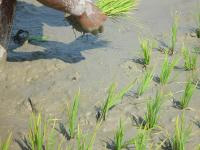 |
 |
 |
 Editorials | Environmental | November 2007 Editorials | Environmental | November 2007  
New Research Shows Climate Change Triggers Wars and Population Decline
 Georgia Institute of Technology Georgia Institute of Technology
go to original


| | A new study in PNAS shows that reduced agricultural productivity caused by climate change triggers wars and population decline. |
Reduced agricultural productivity seems to initiate conflict

Climate change may be one of the most significant threats facing humankind. A new study shows that long-term climate change may ultimately lead to wars and population decline.

The study, published November 19 in the early edition of the journal Proceedings of the National Academy of Sciences (PNAS), revealed that as temperatures decreased centuries ago during a period called the Little Ice Age, the number of wars increased, famine occurred and the population declined.

Data on past climates may help accurately predict and design strategies for future large and persistent climate changes, but acknowledging the historic social impact of these severe events is an important step toward that goal, according to the study’s authors.

“Even though temperatures are increasing now, the same resulting conflicts may occur since we still greatly depend on the land as our food source,” said Peter Brecke, associate professor in the Georgia Institute of Technology’s Sam Nunn School of International Affairs and co-author of the study.

This new study expands previous work by David Zhang of the University of Hong Kong and lead author of the study.

“My previous research just focused on Eastern China. This current study covers a much larger spatial area and the conclusions from the current research could be considered general principles,” said Zhang.

Brecke, Zhang and colleagues in Hong Kong, China and the United Kingdom perceived a possible connection between temperature change and wars because changes in climate affect water supplies, growing seasons and land fertility, prompting food shortages. These shortages could lead to conflict – local uprisings, government destabilization and invasions from neighboring regions – and population decline due to bloodshed during the wars and starvation.

To study whether changes in temperature affected the number of wars, the researchers examined the time period between 1400 and 1900. This period recorded the lowest average global temperatures around 1450, 1650 and 1820, each separated by slight warming intervals.

The researchers collected war data from multiple sources, including a database of 4,500 wars worldwide that Brecke began developing in 1995 with funding from the U.S. Institute of Peace. They also used climate change records that paleoclimatologists reconstructed by consulting historical documents and examining indicators of temperature change like tree rings, as well as oxygen isotopes in ice cores and coral skeletons.

Results showed a cyclic pattern of turbulent periods when temperatures were low followed by tranquil ones when temperatures were higher. The number of wars per year worldwide during cold centuries was almost twice that of the mild 18th century.

The study also showed population declines following each high war peak, according to population data Brecke assembled. The population growth rate of the Northern Hemisphere was elevated from 1400-1600, despite a short cooling period beginning in the middle of the 15th century. However, during the colder 17th century, Europe and Asia experienced more wars of great magnitude and population declines.

In China, the population plummeted 43 percent between 1620 and 1650. Then, a dramatic increase in population occurred from 1650 until a cooling period beginning in 1800 caused a worldwide demographic shock.

The researchers examined whether these average temperature differences of less than one degree Celsius were enough to cause food shortages. By assuming that agricultural production decreases triggered price increases, they showed that when grain prices reached a certain level, wars erupted. The ecological stress on agricultural production triggered by climate change did in fact induce population shrinkages, according to Brecke.

Global temperatures are expected to rise in the future and the world’s growing population may be unable to adequately adapt to the ecological changes, according to Brecke.

“The warmer temperatures are probably good for a while, but beyond some level plants will be stressed,” explained Brecke. “With more droughts and a rapidly growing population, it is going to get harder and harder to provide food for everyone and thus we should not be surprised to see more instances of starvation and probably more cases of hungry people clashing over scarce food and water.” | 
 | |
 |



